

Volume 3, No. 1, Art. 10 – January 2002
Consumers' Views Regarding Health Claims on Food Packages. Contextual Analysis by Means of Computer Support*)
Eva Svederberg
Abstract: Several studies have shown consumers to generally have only a limited understanding of the nutritional information on packaged-food labels. This suggests it is difficult for them to select properly between different foods on the basis of such information. As a basis for information on the requirements of groups of consumers, the present study aimed at investigating how, when presented with health claims and other nutritional information on the labels of food products, consumers' thinking about foods is affected by various background factors as well as by various types of food-related experiences. Semi-structured interviews of 30 consumers in Sweden—men and women aged 25 to 64, with and without food-related health problems—were carried out. The interviews were tape-recorded and were transcribed word-for-word. In the analysis of the interview data, the qualitative methodology of contextual analysis was utilised. For the purpose of method development, the computer programme Atlas.ti was used to support the analysis. The objective of this article is to show step by step how the analysis was carried out. In connection with the analysis, some results are presented. However, the focus in the article is on methodology. The conclusion drawn is that Atlas.ti has qualities that can facilitate the contextual analysis of the interview data.
Key words: methodology, contextual analysis, computer support, Atlas.ti, education, health claims, food labelling
Table of Contents
1. Introduction
2. Design
3. Methodology
3.1 Contextual analysis
3.2 Contextual analysis by means of the computer programme Atlas.ti
3.2.1 Definition of main parts of the objects
3.2.2 Definition of meaning of main parts based on smaller parts
3.2.3 Overall description at the individual level
3.2.4 Sorting for the purpose of categorisation
3.2.5 Categories of description
3.2.6 Delimitation of relations between and within main parts
3.2.7 Similarities and differences between texts
4. Concluding Comments
In terms not only of marketing but also of public health, it is important that consumers with different backgrounds read and understand information about nutrition and health on food packages in the ways intended. Several studies have shown that consumers' understanding of food-label information is low, for example concerning terms used for nutrition information (DALY, 1976; JACOBY, CHESTNUT & SILBERMAN, 1977; HEIMBACH, 1982; MICHEL, KORSLUND, FINAN & JOHNSON, 1994; REID, CONRAD & HENDRICKS, 1996). In relation to the growing use of different statements about health-conducive properties on food packages, it has been shown that consumer understanding of such statements is lacking (FULLMER, GEIGER & PARENT, 1991; REID & HENDRICKS, 1994). Thus, many consumers' possibilities for meaningfully basing their purchases of packaged food on their understanding of the nutritional information on the packages are limited. Considering the results from a study by SVEDERBERG, ASP, LASER REUTERSWÄRD and SVENSSON (1998) that many consumers have a high degree of trust in statements on food package labels as a source of information on nutrition and health, there is a need to gain better insight into how such information can be presented as comprehensible as possible. [1]
The aim of the present study was, by way of an interview study among Swedish consumers, to investigate how, when consumers are presented with health claims and other nutritional information on the labels of food products, their thinking about foods is affected by various background factors as well as by various types of food-related experiences. [2]
For the purpose of method development, the objective of this article is to give an example of how support by a computer programme, in this case Atlas.ti, can be utilised in the qualitative analysis of interview data. Hence, the focus of the article is on methodology. [3]
The interview study reported here was part of a larger study, where data was collected by means of a questionnaire. The aim of the questionnaire study was (a) to investigate to what extent Swedish consumers with different backgrounds read and use food labels as a source of information on the nutritional value of the food in their choice of food products and (b) to investigate how consumers' use of such information and their choice of food products are affected by earlier experiences connected with food. Results of the questionnaire study are reported elsewhere (SVEDERBERG, ASP, LASER REUTERSWÄRD & SVENSSON, 1998; SVEDERBERG, ASP, GUSTAFSSON, LASER REUTERSWÄRD & SVENSSON, 2001). [4]
The interview study involved 30 consumers between 25 and 64 years of age in the municipality of Eslov in southern Sweden. The interviewees were selected from a group of 80 consumers among the 290 in the above mentioned questionnaire study who returned the questionnaire (response rate 65%). With their signatures, these 80 had indicated that they were interested in taking part in an interview study. The basis for the selection of the 30 interviewees was good representation of both sexes, widely differing ages and levels of education, and of persons with and without experience of food-related health problems. [5]
The interviews were carried out in 1999. The interviewees were contacted by phone. As it was about a year since they had answered the questionnaire, they were reminded of that and of their interest at that time in taking part in an interview study. They were then told about the aim and the objective of the study and we arranged when and where to meet. In most cases the interviews took place at the kitchen-table in the interviewee's home. A few took place at their workplace and two of the interviewees chose to come to my office. The duration of each interview was about one hour on average. [6]
Each interview was divided into four parts:
General views on information on food packages
Views on statements on health-conducive properties and information on ingredients and nutrient value on the package of a margarine.
Views on statements on health-conducive properties and information on ingredients and nutrient value on the package of a loaf of bread. [7]
The point of departure in the interviews were relevant food packages, and an interview guide containing specific questions; these being expanded in an exploratory way in conversation. The interviews were tape-recorded and transcribed word-by-word. The study was based on the epistemological assumption that the individual's thinking and pattern of behaviour were developed in relation to, and are the result of earlier formal and informal learning within his/her socio-cultural context: a context that includes social, economic, ecological, regional, educational and professional experiences. [8]
The analysis of interview data involved the use of the methodology of contextual analysis (SVENSSON, 1985, 1997), which was developed in relation to the phenomenographic research approach (MARTON, 1981; SVENSSON, 1997; MARTON & BOOTH, 1997). The analysis of interview data took the form of distinguishing different ways in how food-related experiences appear in consumers' conceptualisation of statements on health-conducive properties on food packages. The analysis was supported by use of a computer program for analysing qualitative data (Atlas.ti) (MUHR, 1997). [9]
An outline of some general characteristics of contextual analysis is given below. This is followed by a description of how the present interview data was processed step by step using contextual analysis by means of the computer program Atlas.ti. Some results are presented in relation to the analysis. However, the objective of this article is to show how the analysis was carried out, and a comprehensive description of the results is to be presented later. [10]
In the phenomenographic research approach, the concern for learning is on how the meanings of objects change for the people or how they conceptualise objects in the surrounding world. The concern for learning here is on the change in knowledge and values as they appear in actions. [11]
The main aim of contextual analysis within a phenomenographic orientation is to delimit objects in the world around us, as conceptualised by subjects, and to find and describe the subjectively experienced meaning of these objects. The whole of how objects are experienced is described in the form of qualitatively different categories of description. The objective in this study was to elucidate conditions that could help improve written communication involving statements on food and nutrition on food packages. In the analysis, this was done through being sensitive to the consumers' own points of departure and priorities in their reading and understanding of texts on food packages. [12]
The scientific knowledge in phenomenographic research is about the qualities of the object or the phenomena in question as a whole, and the qualities of parts in relation to each others as parts of the whole. (To obtain this knowledge, the qualities of parts in relation to each other and as parts of the whole are highlighted.) This way of looking at how knowledge and attitudes are formed is inspired by gestalt psychology. In the phenomenographic research approach, descriptions of experienced meaning have varied based on how global or how analytic they are, i.e. to what extent they describe a general quality of the whole or qualities of parts and relations between parts within the whole. According to SVENSSON (1985), in the use of conception as a principal concept of knowledge, it is important not to delimit the description in terms of a central whole quality, but also to describe how this is expressed in parts and in relations between parts within the whole. Based on this assumption, a methodology was developed which is called contextual analysis (SVENSSON, 1985). [13]
The methodology of contextual analysis is characterised by a holistic analytic approach in the search for knowledge concerning a certain research problem. The starting point for this is the distinction between holistic and atomistic approaches in the search for knowledge, which is based on research on learning (SVENSSON, 1976). SVENSSON found that the search for knowledge in the same material ends up in qualitatively different conceptions depending on the direction of the activities which lead up to a certain conception. SVENSSON (1976) describes the character of the atomistic approach to be that the learner delimits entities externally, e.g. separates facts within a subject-matter, but does not organise these into a whole. The characteristic for the holistic approach, on the other hand, is that the learner organises the parts within a subject-matter into a whole, according to an organising principal. [14]
Among learners with a holistic approach in their learning, qualitatively different conceptions of the same subject-matter were distinguished. This could be brought back to different principles for delimitation of the object or the phenomenon, and to how different learners distinguish parts and organise the whole. SVENSSON (2001) argues that the scientific search for knowledge with the purpose of finding individuals' conceptions of more or less complex objects or phenomena in the world around us, should also consist of a holistic way of distinguishing parts and relations between parts, and between parts and the whole in a fruitful way. The methodology of contextual analysis constitutes a basis for a holistic scientific search for knowledge. [15]
Contextual analysis is based on a general methodological standpoint which at the same time means an emphasis on specific methods being dependent on the context (SVENSSON, 2001). The characteristics of contextual analysis are delimitation of wholes and parts within a given context. Knowledge of the object's quality as a whole is constituted by knowledge of qualities of the object's parts (aspects and components) and relations between these parts. [16]
The contextual character of contextual analysis consists of delimitation of the object or phenomenon as it is conceptualised within the context of which the object or phenomenon is an integral part. The most extensive part of the analysis is to distinguish parts and relations between parts within the object. To use contextual analysis is to work in an exploratory and interpretative manner to elucidate the meaning of different parts in relation to each other and to the object as a whole. The quality of the parts and relations between the quality of different parts together constitute the whole quality of the object and constitute the scientific basis for conclusions. [17]
The result of contextual analysis is presented in the form of qualitatively different categories of description, which are based on whole-qualities or whole-characteristics of the delimited objects. In the description of the results, differences and similarities between experienced meaning represented in the categories are described. [18]
3.2 Contextual analysis by means of the computer programme Atlas.ti
Based on the characteristics of contextual analysis to distinguish parts and relations between parts within delimited objects, it was a thrilling challenge to make use of computer support in different parts of the analysis. For the purpose of method development the software Atlas.ti was used, which is a workbench for qualitative analysis of large bodies of textual, graphical and audio data (MUHR, 1997). In the following passages, different steps of the analysis are explained. Atlas.ti can be utilised in a number of alternative ways depending on the research problem, the aim of the study and the methodological standpoints. The description below is based on the tools in Atlas.ti which were used in the contextual analysis in this study. Other tools were tried in different parts of the analysis, but were not found to be useful, and are therefore excluded from the description below. [19]
The basis for the analysis were thirty interview transcripts, comprising around 600 A4-pages with a wide right-margin (14-32 pages per interview). The preparation of the interview transcripts for use in Atlas.ti included conversion to text-files (*.txt). [20]
Everything that is of relevance to one project, for example for this project consumers' thinking about statements on nutrition and health and other nutritional information printed on food packages, is treated as one entity in Atlas.ti. That entity is called a Hermeneutic Unit and is given a project name of its own. Through the Atlas.ti's main work space all the interview transcripts, in Atlas.ti called Primary Documents (PD), were assigned to the Hermeneutic Unit (HU) created for this project. Bearing in mind the municipality where the research took place, the HU was called "Eslov" (see Illustration 1, the Title Bar). [21]
As the research was carried out among Swedish consumers, the interview data used in the analysis was in Swedish. Swedish was also used in the different parts of the analysis. To facilitate the readers' understanding of how Atlas.ti was utilised in different parts of the analysis, illustrations in the form of screen-shots are used in the text below. Fractions of one interview-transcript (P1: AtlasLS.txt), as well as some Codes, the Code Families and the P-Doc-Families (Categories of Description) are translated into English. This means that the illustrations are not taken directly from the original HU, but from a HU created to illustrate this article. [22]
3.2.1 Definition of main parts of the objects
The foundation of contextual analysis is delimitation of the research object(s). This delimitation is often not clear at the beginning of a study. As the point of departure in this study was the text on two food packages, a margarine and a loaf of bread, the delimitation of the research objects in relation to the aim of the study was rather obvious (see Table 1). [23]
To find main parts of the delimited objects, the interview transcripts (Primary Documents—PD) were coded in Atlas.ti. In the margin area to the right in the main work space of Atlas.ti, selected quotations in each of the primary documents were given a code. The basis for the coding was to obtain participants' understanding of different aspects of the information on the food package labels, especially statements on nutrition and health, and how earlier experiences with food affected these understanding. In accordance with this, the codes chosen were meaning-related, i.e. "What do you mean, fatty acids?" A code not used before is created using the tool in Atlas.ti for that purpose. Once a code is created, and you want to use that code again for another piece of text, you choose from the list of already created codes (see Illustration 1). [24]
To make sure that each one of the quotations (pieces of text) given the same code, indicated the intended meaning of the code, the quotations for each code were read over and over again. The result of this was that some quotations were excluded or were found to represent another code. The use of Atlas.ti facilitated this procedure considerably as all quotations for a certain code are listed, and it is easy to jump between quotations representing the same code in different primary documents (see Illustration 2). During this procedure, the quotations for each code were printed out several times to get a better overview. In Table 1 below the number of codes that were ultimately found to reflect the participants' thinking about statements on health-conducive properties on the packages of the margarine and the bread respectively can be found.
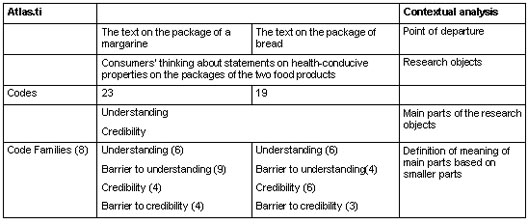
Table 1: The first steps in the contextual analysis by means of Atlas.ti [25]
The codes were then sorted to find main parts of the objects. The findings of this part of the analysis indicated that the participants' thinking about statements on food packages on health-conducive properties of the food were based on two main parts: understanding of the text and the credibility of the statements used (see Table 1). This means that the participants' (consumers') judgements of the two food-products were based in part on their understanding of concepts and statements made and in part on their judgement of the credibility of statements used. The continued analysis focused on how these two main parts, understanding and credibility, were expressed in the participants' thinking. [26]
3.2.2 Definition of meaning of main parts based on smaller parts
To define the meaning of the two main parts, the focus here was to define the meaning of smaller parts as the basis for the meaning of the main parts. In this part of the analysis, the codes for the two food packages (23 and 19 respectively) were sorted into eight groups, four concerning the margarine and four concerning the bread. Through the main work space of Atlas.ti, the codes were then assigned to the so called "Code Families" (see Table 1 and Illustration 3). For each of the two food packages, the four Code Families show (a) participants' thinking that promotes understanding of concepts and statements, (b) participants' thinking that hinders understanding, (c) participants' thinking that promotes credibility of the statements, and (d) participants' thinking that hinders the credibility of statements. The figures in brackets in Table 1 show the number of codes within each Code Family. [27]
3.2.3 Overall description at the individual level
Based on the eight Code Families, networks were built at the individual level using the Network-tool in Atlas.ti. Each participant's networks were based on the eight Code Families. As a preparation for the possibility of importing these eight Code Families to the Network-tool, a short designation of the Code Families was added to the list of Codes through use of the tool "Open coding". [28]
The basis for the Network-tool is the import of Primary Documents (PD), Codes and Quotations. The starting-point for the networks for each participant in the study was to import the current participant's PD and the current Code Family through the "Import Nodes" tool in the Network-tool. [29]
Through the Import Node-tool, the Codes which represent that particular participant's thinking in relation to the current Code Family were then imported to the network and placed under the Code Family in question. The next step was to import Quotation(s) representing the respective codes. An example of a network is shown in Illustration 4. The result of this network-building were five networks for each participant, two regarding the margarine and the bread respectively and one regarding general views on information on food packages. [30]
These networks were then the basis for overall descriptions at the individual level. The descriptions comprise of participants' thinking about information on food packages in general terms, and their thinking about statements on health-conducive properties of the two food packages in relation to their understanding of concepts and the credibility of statements (see Table 2).

Table 2: The next two steps in the analysis [31]
3.2.4 Sorting for the purpose of categorisation
The overall descriptions at the individual level were then sorted for the purpose of categorisation (see Table 2). In this step, as in every step of the analysis described above, comparisons with the whole interview transcripts were also made. The writing of overall descriptions and the sorting of the descriptions for the purpose of categorisation was a delicate analytic and interpretative process. [32]
3.2.5 Categories of description
The contextual analysis resulted in five categories of description which, in five qualitatively different ways, give a comprehensive picture of how food-related experiences are expressed in consumers' thinking about health-conducive characteristics of foods, as expressed on two food packages, a margarine and a loaf of bread (see Table 3).

Table 3: Characteristics of how food-related experiences are expressed in consumers' thinking about statements on nutrition
and health on food packages. The figures in brackets show the number of participants (consumers) in each category. [33]
The five categories of description show that consumers' thinking about statements on nutrition and health on food packages has different points of departure. This means that, when confronted with such statements, consumers' attitudes toward such information is different. [34]
The thinking expressed in the first category of description means that when confronted with statements on nutrition and food on the two food packages, the participants' attention was in the first place directed at facts that are of relevance in relation to their questions on how to eat to live a healthy life in the long term. [35]
In the second category of description, the participants' current health problems or health problems in the participants' families were the basis for their thinking about food and health. This means that when confronted with statements on health-conducive characteristics of foods as expressed on the two food packages, their attention was in the first place directed at facts of relevance in relation to the present health problems. [36]
In the third category of description, the participants conceptualise environmental issues and care for their own health as one entirety and taken as a whole. This means that their choice of food products is based on environmental issues, as well as on issues concerning their own health. Their thinking about statements on nutrition and health on food packages was based on their attention in the first place being directed at whether the food product was locally produced or not, and on the list of ingredients. [37]
The ambivalence among the consumers in the fourth category of description means that they are aware that their eating habits are not the best possible in relation to their understanding of nutritious food as a basis for good health. The direction of their thinking about food and health was based on this ambivalence, and was emphasised (gave the impression of guilt) when they were confronted with statements on health-conducive characteristics of foods, as expressed on the two food packages. [38]
The fifth category of description means that issues on food and health in relation to the participants' traditional eating habits were never problematised. The direction of thinking about statements on health-conducive characteristics on the food products was based on the attitude that choice of such food products does not come into question. [39]
This research is still ongoing and the description of the results is not yet ready. Below you will find a short description of how Atlas.ti was further utilised to facilitate the descriptions of the results to come. [40]
3.2.6 Delimitation of relations between and within main parts
To facilitate the description of the results, the use of Atlas.ti was continued. The Atlas.ti tool "Family Browser" was then opened (Illustration 5). The five Categories of Description described above (see Table 3) were the basis for creation of five "P-Doc-Families". Each of the five Categories of Description were given a short designation and added to the list of Families. Each participant (PD) categorised under their Category of Description was then assigned to their Family in the list of Families. In Atlas.ti vocabulary the assignment mean that they became "Members" of their Family respectively (Illustration 6). [41]
The final step in the analysis was to find by means of Atlas.ti the basis for descriptions of relations between and within main parts of the research objects, that is between and within Understanding and Credibility (see Table 1) among the participants in the five categories of description respectively. At this stage the Code Families (8) were activated one at a time, as well as the P-Doc-Families (5). Through the Atlas.ti tool "Codes" all codes with quotations in each of the eight Code Families were printed out for one of the P-Doc-Families at a time. The result of each of these printouts was a list of the codes categorised under the presently activated Code Family, and the quotations for each code for each Member in the presently activated P-Doc-Family. The description of similarities and differences between and within main parts in the five Categories of Description respectively will be based on eight printouts, (one for each Code Family) for each of the five P-Doc-Families (see Table 4).

Table 4: The final steps in the analysis as a basis for the description of the results [42]
The focus in the descriptions of the results to come is (a) to describe thinking that promotes understanding of the intended meaning of statements on nutrition and health on food packages, and thinking that is a barrier to understanding; (b) to describe thinking that promotes the credibility of statements on nutrition and health on food packages, and thinking that is a barrier to credibility. [43]
3.2.7 Similarities and differences between texts
The same printouts used to describe relations between and within main parts (understanding and credibility) will also be the basis for the description of similarities and differences between the two types of texts: the statements about the health-conducive properties on the packages of the margarine and the bread respectively (see Table 4). [44]
The possibility of computer support in qualitative analysis of data was not yet accessible when I first started to use the methodology of contextual analysis in my research. The development of such possibilities convinced me that it was worth trying. Therefore, already in the planning stage of the present research project, one of the objectives was method development by means of computer support in the qualitative analysis of interview data. [45]
The reason why the software Atlas.ti was chosen is that in the mid-nineties different software programmes were tried here at the Department of Education, Lund University, and at that time Atlas.ti was found to correspond to our demands. I joined an introductory general course, and got some brief ideas of different possibilities for using Atlas.ti in the qualitative analysis of textual data. However, the analysis of my own interview data—from a definite methodological standpoint that of contextual analysis—was a thrilling challenge. I explored Atlas.ti in relation to my methodological standpoint and in relation to the aim of the study. When I faced problems I was not able to sort out myself, I was lucky enough to have access to a colleague who has a good knowledge of the tools which Atlas.ti provides. I also joined the Atlas.ti Mailing List, which is an electronic mailing-list for users of the program. Any user is welcome to use that mailing-list for questions and messages to all members assigned to the list. Any member is welcome to give response to questions, and anyone distributing a question can expect answers within an hour, or certainly within a day. To join the Mailing List, open the Atlas.ti home-page (http://www.atlasti.de/) and follow the instructions given. [46]
My first question to the mailing-list was how can I get in touch with somebody in Sweden who used Atlas.ti in his or her research. I got an answer from a person who was just about to complete a study where he used Atlas.ti in qualitative analysis of interview data. I made an appointment with him, and the experience of the program he shared with me was very useful at the time when I was just about to start my own analysis. [47]
The Atlas.ti workbench offers a large variety of tools to serve the needs of the user. As a novice I was overwhelmed by all the possibilities. Luckily enough, I had the methodology of contextual analysis as a point of departure, and my purpose was then to get support from Atlas.ti in the analysis process. In my experience, it is important to clarify the methodological standpoints before getting started, to prevent the risk of getting lost. To sum up my experience, Atlas.ti has indeed got qualities that facilitated the contextual analysis of interview data in this study. [48]
This study is part of a larger project supported by KLIV (Knowledge Platform for the Food Industry in Sweden). My thanks to Ulf TORPER, PhD, Department of Education, Lund University for valuable introductory instructions in the use of Atlas.ti. I also want to thank Professor Lennart SVENSSON, Department of Education, Lund University, Professor Nils-Georg ASP, Department of Applied Nutrition and Food Chemistry, Lund University and Dr Anita LASER REUTERSWÄRD, Swedish Nutrition Foundation for their support in different parts of the study.
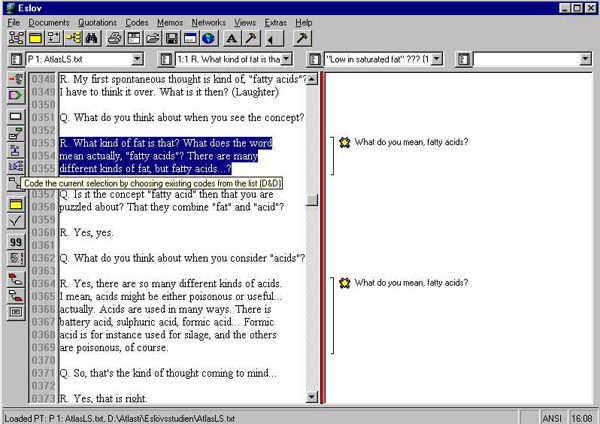
Illustration 1: In this screen shot, a text segment is marked. A code was selected among existing codes in the "Code by List"
in the Primary Docs Toolbar, left of the line numbers. The code chosen is seen in the Margin Area to the right.
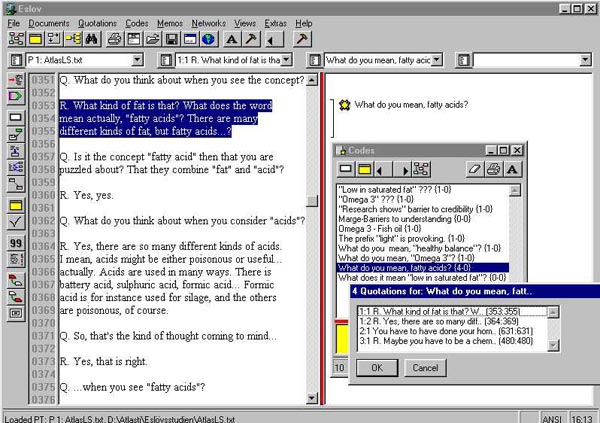
Illustration 2: The screen shot illustrates that one code is marked in the list of codes shown in the Margin Area. After a
double-click on the marked code, all quotations for that code are shown. The first quotation is marked and the same quotation
is at the same time found and marked in the Primary Document Area.
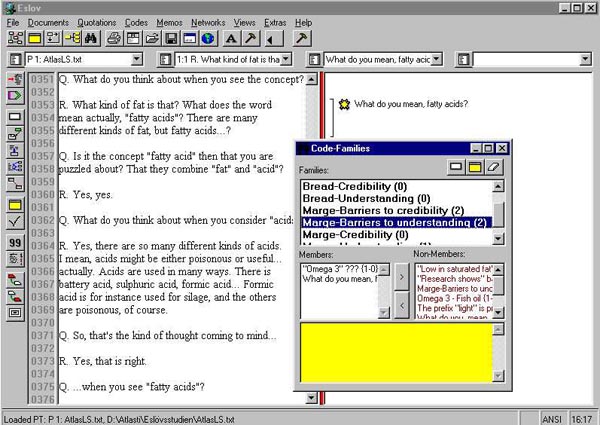
Illustration 3: Five of the eight Code Families are shown here and two of the codes assigned to the Code Family "Marge-Barriers
to understanding" are shown as so-called "Members" of that Family.
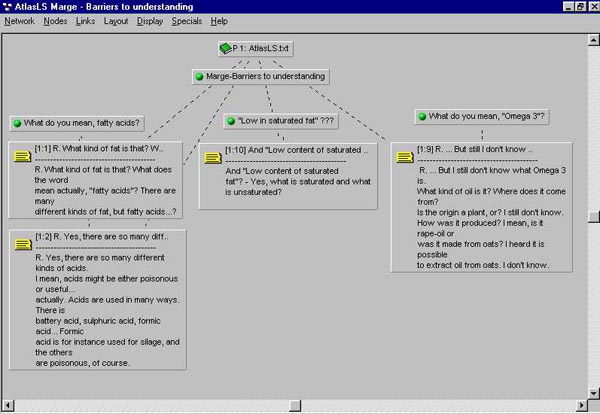
Illustration 4: An example of a Network.
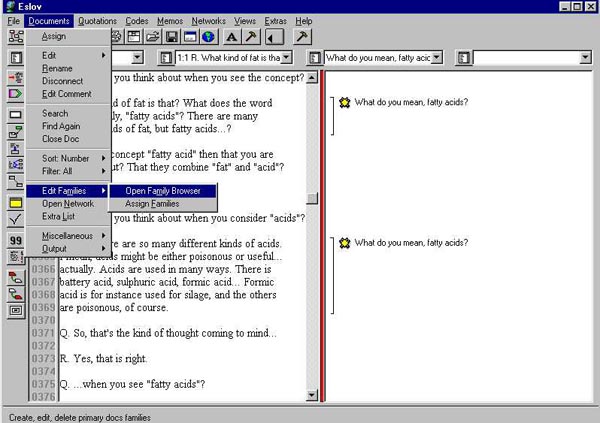
Illustration 5: A single click on "Documents" in the Main menu, opens the Drop Down List, where "Edit Families" and then "Open
Family Browser" is opened with a single click.
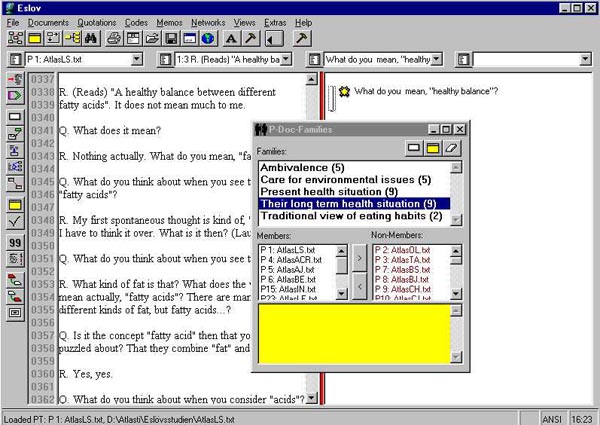
Illustration 6: The five Categories of Description below were given a short designation and added to the list of Families.
The participants (consumers) categorised under each Family are assigned as Members of the presently activated Family.
*) For more detailed results see also Report 21, Lund University (PDF file, 213 kb). <back>
1) The keyhole symbol can be used in Sweden on food products with low fat or high fibre content compared with other food products in a given food product category. <back>
2) KRAV stands for the Society for Marking of Ecologically Grown Food, indicating that the food was produced without the use of fertilisers or pesticides. <back>
Daly, Patricia A. (1976). The response of consumers to nutrition labeling. The Journal of Consumer Affairs, 10(2), 170-178.
Fullmer, Susan; Geiger, Constance J. & Parent, C. R. Michael (1991). Consumer's knowledge, understanding, and attitudes toward health claims on food labels. Journal of American Dietetic Association, 91(2), 166-171.
Heimbach, James T. (1982). Public understanding of food label information. Report published by the Food and Drug Administration, Bureau of Foods, Division of Consumer Studies, Washington D.C.
Jacoby, Jacob; Chestnut, Robert W. & Silberman, William (1977). Consumer use and comprehension of nutrition information. Journal of Consumer Research, 4, 119-128.
Marton, Ference (1981). Phenomenography. Describing conceptions of the world around us. Instructional science, 10, 177-200.
Marton, Ference & Booth, Shirley (1997). Learning and awareness. New Jersey: Lawrence Erlbaum Associates.
Michel, Patricia M.; Korslund, Mary K.; Finan, Amelia & Johnson, Janet (1994). Food label reading habits of WIC (Special supplemental food program for women, infants and children) clients. Journal of Nutrition Education, 26(3), 146-148.
Muhr, Thomas (1997). Atlas.ti Visual Qualitative Data Analysis Management Model Building in Education Research & Business. Short User's Manual. Berlin: Scientific Software Development.
Reid, Debra J.; Conrad, Sheryl A. & Hendricks, Suzanne M. (1996). Tracking nutrition trends, 1989-1994. An update on Canadians' attitudes, knowledge and reported actions. Canadian Journal of Public Health, 87(2), 113-118.
Reid, Debra J. & Hendricks, Suzanne M. (1994). Consumer understanding and use of fat cholesterol information on food labels. Canandian Journal of Public Health, 85(5), 334-337.
Svederberg, Eva; Asp, Nils-Georg; Laser Reuterswärd, Anita & Svensson, Lennart (1998). Hur konsumenter läser och använder texten på livsmedelsförpackningar (How consumers read and use text on food packages). (Unpublished).
Svederberg, Eva; Asp, Nils-Georg; Gustafsson, Jan-Eric; Laser Reuterswärd, Anita & Svensson, Lennart (2001). Influence of earlier experiences on consumers' reading and use of nutritional information on food packages. A questionnaire involving structural equation modeling (Submitted).
Svensson, Lennart (1985). Contextual analysis: The development of a research approach. Paper presented at the 2nd Conference on Qualitative Research in Psychology, Leuden, The Netherlands.
Svensson Lennart (1976). Study Skill and Learning. Diss. Göteborg Studies in Educational Sciences, 19). Göteborg: Acta Universitatis Gothoburgensis.
Svensson, Lennart (1997). Theoretical foundations of phenomenography. Higher Education Research and Development, 16(2), 159-171.
Svensson, Lennart (2001). Contextual analysis (Preliminary version). Lund: Department of Education, Lund University.
Eva SVEDERBERG, PhD, is a researcher at the Department of Education, Lund University, Sweden. She is also a senior lecturer at the Department of Behavioural Sciences, Kristianstad University. Her field of research is food and nutrition from an educational perspective, where the individual consumer's perspective is a primary point of departure. Within this field of research, questions on methodology are of current interest.
Contact:
Eva Svederberg, PhD
Senior Lecturer, Researcher
Department of Education
Lund University
SE—221 00 Lund, Sweden
Phone: +46 46 222 87 19
E-mail: eva.svederberg@hkr.se
Svederberg, Eva (2001). Consumers' views regarding health claims on food packages. Contextual analysis by means of computer support [48 paragraphs]. Forum Qualitative Sozialforschung / Forum: Qualitative Social Research, 3(1), Art. 10, http://nbn-resolving.de/urn:nbn:de:0114-fqs0201109.
Revised 11/2008